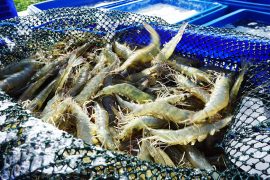
Bacteria use biological clocks to predict and survive cold weather
In our animated world, life teems with activity day and night. Unseen to the human eye, tiny bacteria – the oldest life forms on Earth – have a secret internal rhythm that they use to sense the arrival of new seasons. Bacteria are, in fact, able to “set” their internal 24-hour clocks to predict the coming cold.
Biological clock of bacteria
Findings from a recent study could give a fresh insight into adapting to climate change. The focus of the study was cyanobacteria, a type of blue-green algae. Researchers created an artificial environment with varying day lengths at a constant warm temperature to see how these tiny organisms would react.
The bacteria were exposed to either short days, equinox days (equal light and dark), or long days – all part of an “ice bucket challenge.”
Icy stress test
After eight days, the cyanobacteria were subjected to an ice bath for two hours, and survival rates were observed.
These microscopic organisms, which had been conditioned to a sequence of short days before the icy stress test, had survival rates of 75%. Astoundingly, this was up to three times higher than those that had not been prepped in this way.
Just one short day wasn’t enough to boost their cold resistance. It took a series of short days, ideally six to eight, for their chance of survival to notably improve.
Role of biological clocks in bacteria
Interestingly, when these bacteria had their biological clock genes removed, their survival rates were the same regardless of day lengths.
What does this tell us? It shows that their ability to measure the day-night cycle – known as photoperiodism – is crucial for adapting to longer-term environmental changes such as a new season or climate shifts.
“After a certain number of short days, similar to autumn, they ‘switch’ to a different physiology in anticipation of the wintry challenges that lie ahead,” explained Dr. Luísa Jabbur, the first author of the study.
Dr Jabbur conducted this research under the guidance of Professor Carl Johnson at Vanderbilt University, Tennessee, and currently holds a BBSRC Discovery Fellow at the John Innes Centre.
Bacteria, clocks, and seasons
Previous studies have shown that bacteria possess a version of a biological clock, which could offer an evolutionary advantage by measuring differences in day-night length. But this research is the first of its kind to demonstrate that photoperiodism in bacteria evolved to anticipate seasonal cues.
The question that this uncovers is, how does an organism with a lifespan of just six to 24 hours evolve a mechanism not merely to react to, but to anticipate, future conditions?
“It’s like they are signaling to their daughter cells and their granddaughter cells, passing information that the days are getting short, you need to do something,” said Dr. Jabbur.
What’s next for our tiny organisms?
The John Innes Centre, where Dr. Jabbur is currently based, will further use cyanobacteria to understand how photoperiodic responses might evolve in other species during climate change.
Dr Jabbur believes that unlocking the secrets of these tiny organisms could hold the key to major future advancements, such as improving crop resilience in the face of climate change.
Bacteria clocks and agriculture
The implications of this research extend far beyond the microscopic world of cyanobacteria. Understanding how these organisms adapt their physiological responses in anticipation of environmental changes could potentially transform agricultural practices.
If we can harness the mechanisms of photoperiodism in bacteria, we might be able to enhance crop resilience against climate variances and extreme weather patterns.
By selectively breeding or genetically modifying crops to respond similarly, we can create varieties that are better equipped to handle sudden changes in temperature or precipitation, thus ensuring food security in a tumultuous climate landscape.
Broadening our perspective
This discovery on the biological clock of bacteria also encourages a re-evaluation of the role that microbial life plays within ecosystems. Traditionally, bacteria have been viewed largely through the lens of their immediate impacts on health and decay.
Yet, as these findings illustrate, bacteria exhibit remarkable adaptations to environmental shifts, suggesting a more profound ecological intelligence than previously acknowledged.
This broadened perspective invites us to consider the contributions of microorganisms in not only maintaining ecosystem balance but also in addressing the challenges posed by climate change.
Through a collaborative effort that merges microbiology, ecology, and agricultural science, we can better appreciate and leverage the incredible capabilities of these tiny life forms in our quest for sustainability.
A laugh and a legacy
This discovery is indeed a promising scientific breakthrough for Dr Jabbur, who faced initial skepticism from her scientific mentor, Professor Carl Johnson. But as they say, the proof is in the pudding, and her experiments were successful.
“As well as being a fascinating person and an inspiration, Carl sings in the Nashville Symphony Chorus, and he has an operatic laugh! It echoed round the department when I first outlined my idea for the icy challenge, to see if photoperiod was a cue for cyanobacteria in their natural element,” said Dr. Jabbur.
“To be fair he told me to go away and try it, and as I went, he showed me a sign on his door with the Frank Westheimer quote: ‘Progress is made by young scientists who carry out experiments that old scientists say would not work.’
“It did work, first time. Then I repeated the experiments. There is something very precious about looking at a set of plates with bacteria on them and realizing that in that moment you know something that nobody else knows.”
The study is published in the journal Science.
—–
Like what you read? Subscribe to our newsletter for engaging articles, exclusive content, and the latest updates.
Check us out on EarthSnap, a free app brought to you by Eric Ralls and Earth.com.
—–













